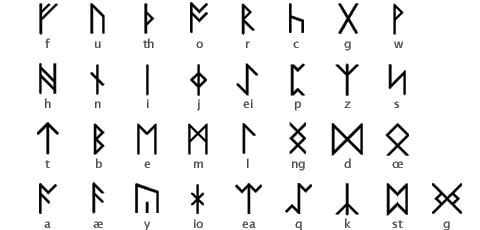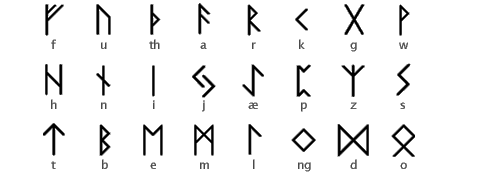Runes are an ancient Germanic alphabet, used for writing, ascribed with various magical, mystical, and divinatory properties. These various alphabetical signs have been passed down through the centuries and were thought to possess religious and magical meanings. The word “rune” actually means mystery or secret.
Each rune has esoteric meanings and properties associated with it, beyond its mundane meaning and phonetic value. Each translates into a word or a phrase signifying concepts important to the early peoples who used them. They represented the forces of nature and mind. According to myth, the runes were created by the Norse god, each having a unique story attached.
They were used throughout northern Europe, Scandinavia, the British Isles, and Iceland from about 100 B.C.E. to 1600 C.E. Runic inscriptions of great age have even been found in North America, supporting stories that the Vikings arrived in the Americas long before Columbus.
RUNIC ALPHABET
The runic characters, originally derived from the Roman alphabet first appeared among German tribes in central and Eastern Europe. They numbered 24, divided into three groups called Aettas, which corresponds closely to the phonetic sounds of the Roman alphabet. Some runes symbols are likely to have been acquired from other alphabets, such as the Greek, Etruscan, and the Early Roman. The runes were made of straight lines to make the characters suitable for cutting into wood or stone.
The earliest runic inscriptions on stone are dated to the late 3rd century AD, although it is probable that runic alphabets had been in use for some centuries before.
The three well known runic alphabets are:
ELDER FUTHARK(CA. 150 TO 800 AD)
Elder futhark is the oldest form of the runic alphabet used by the Germanic tribes of Sweden, Norway, Denmark, and Northern Germany. The name “futhark,” is derived from the first 6 letters in the runic sequence: F, U, Th, A, R and K. The futhark originally consisted of 24 letters, beginning with F and ending with O. This form of the runes is known as Germanic Futhark.
ANGLO-SAXON FUTHORC (400 TO1100 AD)
The Anglo-Saxon Futhorc descended from the Elder Futhark of 24 runes and contained between 26 and 33 characters. There are theories that it was developed in Frisia (northern Netherlands and north-western Germany) coinciding with the Anglo-Saxon Invasion, due to the appearance of similar runes in the British Isles. The forms of several runes changed during this period, in particular the runes for A/O, C/K, H, J, S, and Ng. These changes in the language led to between five and nine runes being added to the alphabet to compensate for the extra sounds, and several runes were given different corresponding letters.

YOUNGER FUTHARK (800 TO 1110)
The Younger Futhark was reduced from the Elder Futhark consisting of 24 characters to 16 characters, in which several runes came to represent multiple sounds. The forms of the runes were also changed and simplified. Nine of the original Elder Futhark letters were dropped (g, w, æ, p, z, e, ng, d, and o), and a new one was created (R). There were two major varieties of Younger Futhark, namely Danish (long-branch) and Swedish-Norwegian(short-twig).












